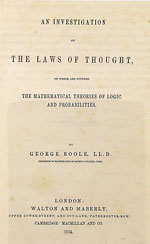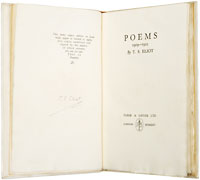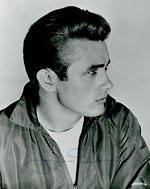Collecting Print
All those ‘Bits’ began with Boolean logic
George Boole, An Investigation of the Laws of Thought, Bloomsbury Auctions of London on March 10, £3,600 ($5,370)
The author’s name and the term Boolean logic will probably be familiar to, if not widely understood by today’s computer generation, and though not in the Newton price bracket, this is another landmark of science.
This is the work in which Boole explained his mathematical theories of logic and probability. As the catalogue of the great Haskell F. Norman science library points out:
“Boole invented the first practical system of logic in algebraic form, which enabled more advances in logic to be made in the decades of the nineteenth century than in the twenty-two centuries preceding. Boole’s work led to the creation of set theory and probability theory in mathematics, to the philosophical work of Peirce, Russell, Whitehead and Wittgenstein, and to computer technology via the master’s thesis of C. E. Shannon (1937), who recognised that the true/false values in Boole’s two-valued algebra were analogous to the open and closed states of electric circuits. This invention of the binary digit or ‘bit’ made possible the development of the digital computer.”
In original cloth, albeit now a little damp-stained to the covers, this copy is thought to be an example of the earliest of the three 1854 issues identified by Norman.
Tom Eliot’s Poems, Signed and Reinstated
T.S. Eliot, Poems 1909-25, Leslie Hindman of Chicago on March 16, $6,100 and Poems 1909-25, Bonhams of Oxford on February 23, £1,560 ($2,430); Collected Poems 1909-35, Christie’s South Kensington on November 23, £3,500 ($5,800)
Part of a collection of the writer’s works sent to auction (to benefit its acquisitions fund) by the High Museum of Art in Atlanta, Georgia, this was one of just 85 special signed and numbered copies of Poems 1909-25. It was issued just a couple of months after the regular trade first by Faber & Gwyer (later Faber & Faber), the London publishing house which Eliot had just joined and with whom he was to spend the rest of his working life, eventually being appointed a director.
The Chicago example showed some foxing to the preliminaries and elsewhere, but the slightly discolored white cloth-backed boards sported a thick glassine wrapper. Was this as originally issued, I wonder?
Another copy of this limited edition seen at Bonhams Oxford on February 23 lacked such a protective jacket and those white boards were soiled and darkened at the spine. The price reflected this.
These recent sales remind me that on November 23 last, a very interesting copy Faber & Faber’s 1936 issue of Collected Poems 1909-35 came up for sale in London. A copy that he gave to a priest, Geoffrey Curtis, it had the line “the ivory men make company between us” restored in Eliot’s hand to ‘A Game of Chess’ in part II of The Waste Land. Eliot’s wife, Vivienne, is said to have found the line too personal and it was removed from the published version, but Eliot obviously cared for it and restored in this and at least one other recorded copy.
The cloth binding was poor but Eliot’s autograph reinstatement of the line that had upset Vivienne pushed the price to a record £3,500 ($5,800).
James Dean, Rebel and Teenage Icon
Signed Photograph of James Dean, International Autograph Auctions of Nottingham on February 13, £6,230 ($9,705)
I must admit to being largely uninformed about the market in signed photographs of Hollywood stars. But James Dean, who, when I was a young lad, was a teenage cultural icon (if indeed we knew that phrase at the time) and someone that your parents would certainly not understand, is obviously still a big attraction. This 8 x 10-inch portrait shows the actor in costume as the troubled Jim Stark in the 1955 film most closely associated with that image, Rebel Without a Cause.








 Ian McKay’s weekly column in Antiques Trade Gazette has been running for more than 30 years.
Ian McKay’s weekly column in Antiques Trade Gazette has been running for more than 30 years.

